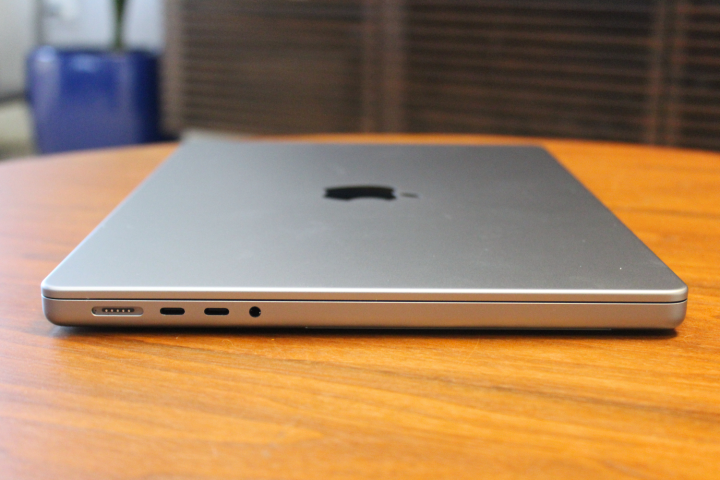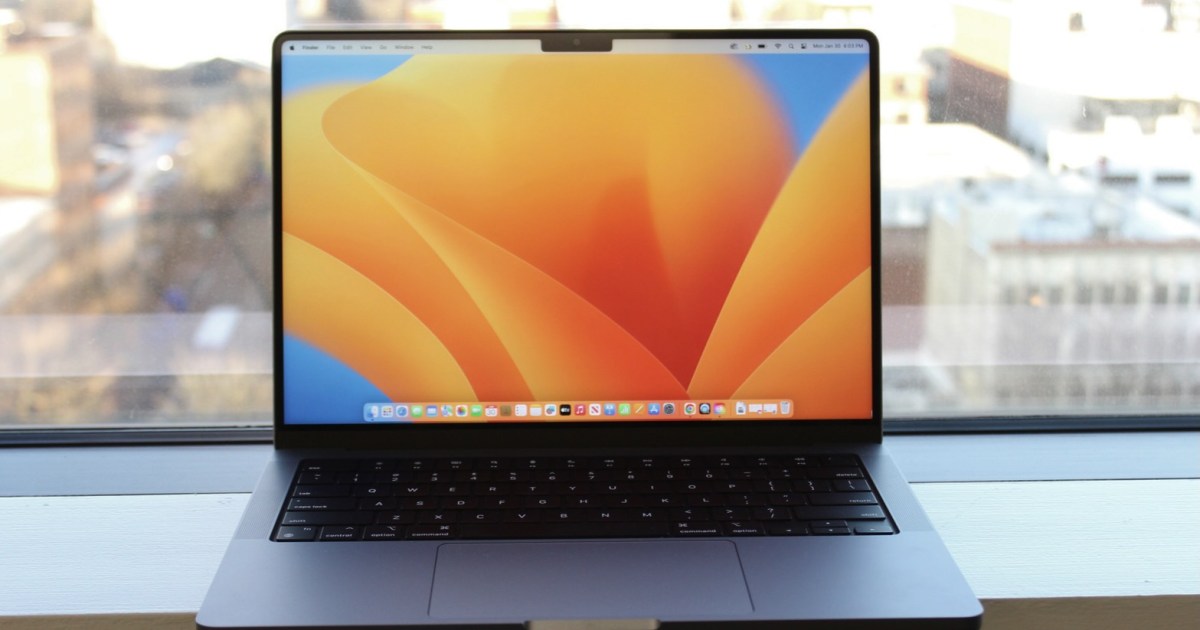If you’re looking for a great 14-inch laptop, the Apple MacBook Pro 14 should be on your shortlist. It’s fast, incredibly well-built, has a great mini-LED display, and enjoys the longest battery life around. It’s also very expensive.
Enter the Acer Swift X 14. It’s also fast, has a spectacular OLED display, and is one of a rare breed of non-gaming 14-inch machines with a very fast GPU. It’s also a lot more affordable. Can it compete with the very best?
Specs and configurations
| Acer Swift X 14 SFX14-72G | Apple MacBook Pro 14 | |
| Dimensions | 12.71 inches x 8.98 inches x 0.74-0.80 inches | 12.31 inches x 8.71 inches x 0.60 inches |
| Weight | 3.4 pounds | 3.5 pounds |
| Processor | Intel Core Ultra 7 155H | Apple M3 (8-core) Apple M3 Pro (11-core, 12-core) Apple M2 Max (14-core, 16-core) |
| Graphics | Nvidia GeForce RTX 4050 Nvidia GeForce RTX 4070 |
M3: 10-core M3 Pro: 14-core, 18-core M3 Max: 30-core, 40-core |
| RAM | 16GB 32GB |
M3: 8GB to 24GB M3 Pro: 18GB to 128GB M3 Max: 36GB to 128GB |
| Display | 14.5-inch 16:10 2.8K (2880 x 1800) OLED, 120Hz | 14.2-inch 16:10 Liquid Retina XDR (3024 x 1964), 120Hz |
| Storage | 1TB SSD | 512GB SSD 1TB SSD 2TB SSD 4TB SSD 8TB SSD |
| Touch | Yes | No |
| Ports | 2 x USB-C with Thunderbolt 4 1 x USB-A 3.2 Gen 2 1 x USB-A 3.2 Gen 1 1 x HDMI 2.1 1 x 3.5mm audio jack 1 x microSD card reader |
3 x USB-C with Thunderbolt 4 1 x HDMI 2.0 1 x 3.5mm audio jack SD card reader |
| Wireless | Wi-Fi 6E and Bluetooth 5.3 | Wi-Fi 6E and Bluetooth 5.3 |
| Webcam | 1080p | 1080p |
| Operating system | Windows 11 | MacOS Monterey |
| Battery | 76 watt-hours | 70 watt-hours |
| Price | $1,400+ | $1,599+ |
| Rating | 4 out of 5 stars | 4.5 out of 5 |
The Swift X 14 has two configurations available, starting with the base model at $1,400 for an Intel Core Ultra 7 155H chipset, 16GB of RAM, a 1TB SSD, an Nvidia GeForce RTX 4050 GPU, and a 14.5-inch 2.8K OLED display. The high-end model, which we reviewed, is $1,700 with 32GB of RAM and an RTX 4070.
The MacBook Pro 14 is a more expensive laptop, especially when similarly configured. The base model is $1,599 for a base M3 8-core CPU/10-core GPU M3 chipset, 8GB of RAM, a 512GB SSD, and a 14.2-inch mini-LED display. With an 11-core CPU/14-core GPU M3 Pro, 18GB of RAM, and a 512GB SSD, the MacBook costs $1,999. The much more powerful 14-core CPU/30-core GPU M3 Max starts at $2,399 with 18GB of RAM and a 512GB SSD. When fully configured, the MacBook Pro 14 costs $6,899 for a 16-core CPU/40-core GPU M3 Max, 128GB of RAM, and an 8TB SSD.
Probably the most relevant MacBook Pro 14 configuration when compared with the Swift X 14’s high-end model is the M3 Pro, 36GB of RAM, and 1TB SSD that runs $2,599. That makes the Swift X 14 a relative bargain by comparison.
Design

If you’re reading this comparison, we’ll assume that you don’t have a strong preference between macOS and Windows 11. If you do, then there’s little here that will sway you in a different direction.
What does matter is relative build qualities, and here, the MacBook Pro 14 has a distinct advantage. It’s one of the best-built laptops you can buy today, crafted from a CNC machine chunk of aluminum. It’s incredibly solid and exudes quality. The Swift X 14 is also well-built, though, with its own aluminum chassis and lid that resists bending, flexing, and twisting. It’s not that the Swift X 14 isn’t a very solid laptop, it’s just that the MacBook Pro 14 is that much better. For most people, though, there’s not enough of a difference to justify a lot more money.
The MacBook Pro 14 is a smaller laptop, in width, depth, and particularly thickness. It’s also slightly heavier, which gives it a denser feel. The Swift X 14 by comparison is a bit chunky. That contributes to the MacBook having a more elegant aesthetic, which is compounded by its simpler lines and overall design compared to the Swift X 14’s more rocket-science lines and venting. Again, the Swift X 14 isn’t bad, it’s just that the MacBook is better.
The MacBook’s Magic Keyboard is also better, if you appreciate shallower switches that are light and snappy and larger keycaps with more key spacing. If you like deeper travel, then the Swift X 14’s keyboard is also good, although its keycaps are smaller and there’s not as much spacing. The MacBook’s Force Touch haptic touchpad is a bigger difference, though, compared to the Swift X 14’s more pedestrian mechanical version.
In terms of connectivity, the Swift X 14 has more ports and greater legacy support, while the MacBook Pro 14 has an additional Thunderbolt 4 port, a full-size SD card reader, and a separate MagSafe 3 power connector. Both have the same level of wireless connectivity.
Finally, both laptops have 1080p webcams that provide good but not great image quality. The Swift X 14’s Neural Processing Unit (NPU) in the Intel Meteor Lake chipset supports Microsoft’s Studio Effects software and so has hardware-assisted blurring, facial tracking, and other tools. Both laptops have fingerprint readers embedded in their power buttons for logging in without a password.
Performance

The Swift X 14 can be configured with the 28-watt Core Ultra 7 155H with 16 cores (six Performance, eight Efficient, and two Low Power Efficient) and 22 threads and with either the entry-level Nvidia GeForce RTX 4050 or the much faster RTX 4070, the latter of which is unusual in non-gaming 14-inch Windows laptops. That compares to the MacBook Pro 14 that can run the base M3 with eight CPU cores and 10 GPU cores, the M3 Pro with up to 12 CPU cores and 18 GPU cores, and the M3 Max with up to 16 CPU cores and 40 GPU cores.
We tested the Swift X 14 with the RTX 4070. We tested the MacBook Pro 14 with the M3 Max 16/40, and the MacBook Air M3 is put in as a proxy for the base MacBook Pro 14 model, which would be slightly faster given the Pro’s better thermals. In our CPU benchmarks, the M3 Max was much faster across the board. We didn’t run the latest version of the Pugetbench Premiere Pro on the 14-inch MacBook Pro, but the 16-inch model that’s only slightly faster scored 8,046. The base M3 was slower than the Swift X 14.
It’s likely that when similarly configured, that is, when compared to the MacBook Pro 14 M3 Pro, the Swift X 14 would be a competitive laptop that’s as fast for demanding productivity users and creators and faster for gamers. And it will cost significantly less.
| Geekbench 6 (single/multi) |
Handbrake (seconds) |
Cinebench R24 (single/multi/GPU) |
Pugetbench Premiere Pro |
|
| Acer Swift X 14 (Core Ultra 7 155H / RTX 4070) |
Bal: 2,149 / 12,523 Perf: 2,172 / 12,591 Turbo: 2,173 / 12,686 |
Bal: 67 Perf: 66 Turbo: 65 |
Bal: 106 / 805 / 8,093 Perf: 107 / 842 / 9,110 Turbo: 107 / 887 / 9,600 |
Bal: 4,204 Perf: 4,678 Turbo: 5,168 |
| MacBook Pro 14 M3 (M3 Max 16/40) |
3,174/ 21,137 | 53 | 139/ 1,522 / 12,765 | N/A |
| MacBook Air (M3 8/10) |
3,102 / 12,078 | 109 | 141 / 601 / 3,049 | 3,633 |
Display and audio

The Swift X 14 has one display option, a 16:10 2.8K (2880 by 1800) OLED panel running at 120Hz. The MacBook Pro 14 also has one display option, a 16:10 3024-by-1964 mini-LED panel also running at 120Hz. On paper, the MacBook’s display is considerably sharper.
By every objective measure other than brightness, the Swift X 14’s OLED display is superior to the MacBook Pro 14’s mini-LED display. It has wider and more accurate colors, and its contrast is higher with inky blacks. Where the MacBook wins is in its intense, 1,600-nit high dynamic range (HDR) brightness. For media consumers and anyone else who’s concerned about great HDR performance, the MacBook Pro wins.
| Acer Swift X 14 (OLED) |
Apple MacBook Pro 14 (Mini-LED) |
|
| Brightness (nits) |
405 | 511 |
| AdobeRGB gamut | 95% | 89% |
| sRGB gamut | 100% | 100% |
| Accuracy (DeltaE, lower is better) |
0.87 | 1.13 |
Audio is a completely different story. The Swift X 14 has just two upward-firing speakers that produce passable sound. The MacBook Pro 14 has a standout six-speaker setup with force-cancelling woofers that produces loud, incredibly clear sound with more bass than most laptops.
Portability

The MacBook Pro 14 is smaller and roughly the same weight as the Swift X 14, making it a denser laptop. Both are reasonably portable, though.
Battery life is another massive win for the MacBook Pro 14, which is one of the most efficient laptops you can buy today. Where the Swift X 14 managed just 7.25 hours in our web browsing and video tests, the MacBook Pro 14 with the M3 Max 16/40 should come in around 17 hours and 25 hours, respectively.
Simply put, while the Swift X 14 will last well under four hours when running intensive tasks, the MacBook Pro 14 can last for a full day or more. It’s not contest.
The MacBook Pro 14 is better, but only if you spend enough money
If you have a large budget and macOS works for you, then the MacBook Pro 14 is the best 14-inch laptop you can buy. It’s incredibly well built, has excellent performance and phenomenal battery life, and its mini-LED display is the best for HDR.
However, Windows users with less money to spend can’t go wrong with the Swift X 14. It’s the fastest non-gaming Windows 14-inch machine, has an excellent OLED display, and it’s built well enough that you’ll be glad you spend a lot less money for it.
Editors’ Recommendations







